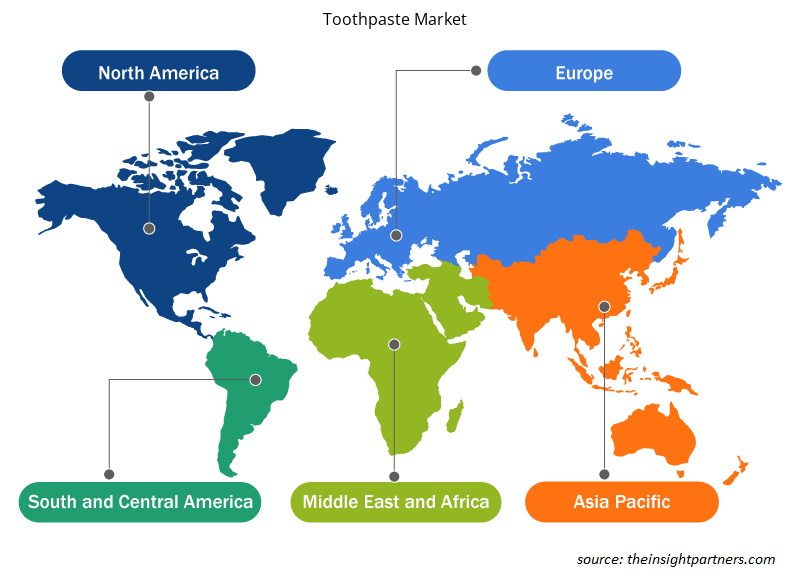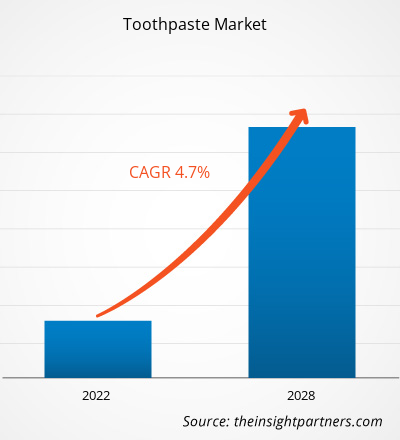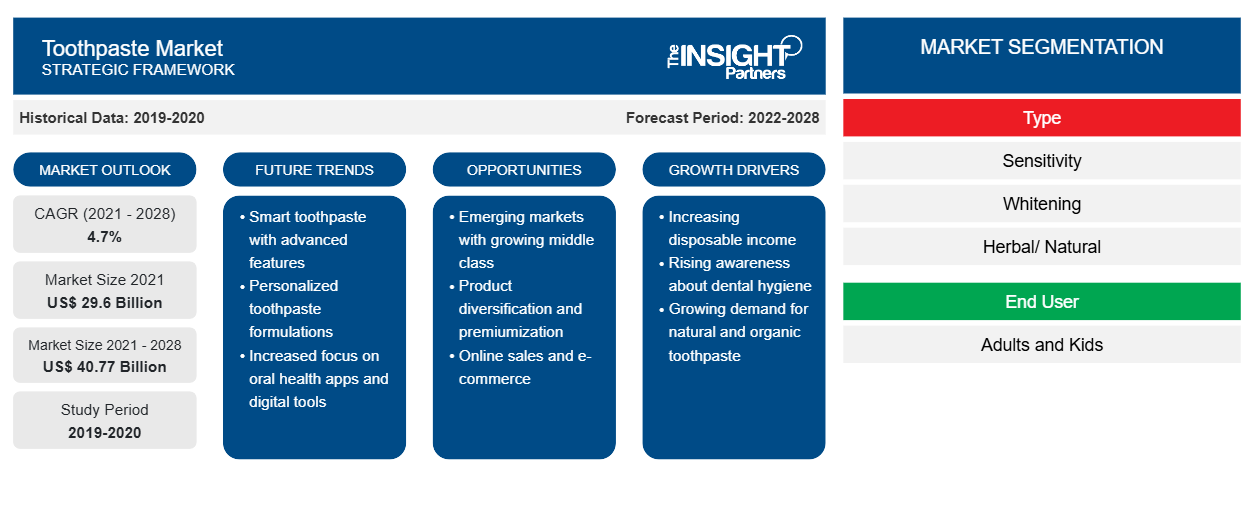[Forschungsbericht] Der Zahnpastamarkt wurde im Jahr 2021 auf 29.598,97 Millionen US-Dollar geschätzt und soll bis 2028 40.766,21 Millionen US-Dollar erreichen; es wird erwartet, dass er von 2021 bis 2028 mit einer durchschnittlichen jährlichen Wachstumsrate von 4,7 % wächst.
Mengenmäßig dürfte der weltweite Bedarf an Zahnpasta bis 2028 auf über 19 Milliarden Einheiten steigen.
Eine Zahnpasta besteht aus verschiedenen Bestandteilen. Die drei wichtigsten sind Schleifmittel, Fluorid und Reinigungsmittel. Zahnpasta dient der Mundhygiene: Sie ist ein Schleifmittel, das hilft, Plaque und Speisereste von den Zähnen zu entfernen, Mundgeruch zu unterdrücken und Wirkstoffe (meistens Fluorid) zur Behandlung von Karies und zur Vorbeugung von Zahnfleischerkrankungen enthält.
Im Jahr 2020 hatte der asiatisch-pazifische Raum den größten Anteil am weltweiten Zahnpastamarkt . Süd- und Mittelamerika werden im Prognosezeitraum voraussichtlich die höchste durchschnittliche jährliche Wachstumsrate verzeichnen. Der Zahnpastamarkt in der Region umfasst mehrere Volkswirtschaften wie Australien, Indien, China, Japan, Südkorea und den Rest des Asien-Pazifik-Raums . Die wichtigsten Faktoren, die den Zahnpastamarkt antreiben, sind eine starke Kundenbasis, ein gestiegenes Bewusstsein für Mundgesundheit und -hygiene sowie Veränderungen im Lebensstil. In Indien ist Zahnempfindlichkeit sehr verbreitet. In der Region besteht eine hohe Nachfrage nach bedarfsgerechten Angeboten wie Zahnpasta gegen Zahnempfindlichkeit, aufhellende Zahnpasta, Zahnpasta auf Gelbasis oder Zahnpasta mit pflanzlichen und natürlichen Inhaltsstoffen. Diese Zahnpastakategorien werden in den nächsten Jahren einen größeren Anteil erreichen. Es besteht eine hohe Nachfrage nach Zahnpasta mit unterschiedlichen Geschmacksrichtungen. Mit einer deutlichen Verschiebung der Verbrauchernachfrage nach natürlicher Zahnpasta wächst das natürliche und pflanzliche Untersegment des Zahnpastamarktes schneller.
Passen Sie diesen Bericht Ihren Anforderungen an
Sie erhalten kostenlos individuelle Anpassungen an jedem Bericht, einschließlich Teilen dieses Berichts oder einer Analyse auf Länderebene, eines Excel-Datenpakets sowie tolle Angebote und Rabatte für Start-ups und Universitäten.
-
Holen Sie sich die wichtigsten Markttrends aus diesem Bericht.Dieses KOSTENLOSE Beispiel umfasst eine Datenanalyse von Markttrends bis hin zu Schätzungen und Prognosen.
Die COVID-19-Pandemie hat die gesamte Körperpflegebranche stark beeinträchtigt. Einzelhändler für Körperpflegeprodukte sind gezwungen, nur noch lebensnotwendige Produkte wie Lebensmittel, Getränke und Körperhygieneprodukte wie Zahnpasta, Desinfektionsmittel und Seifen zu priorisieren, während gleichzeitig die Sortimentsgrößen und Lagereinheiten ( SKUs ) anderer Produktkategorien wie Kräuterzahnpasta reduziert wurden. Der weltweite Lockdown aufgrund der COVID-19-Pandemie hat das Kaufverhalten der Verbraucher besonders beeinflusst, indem er deren Kaufgewohnheiten geprägt hat. Infolge des Ausbruchs verschiebt sich die Neigung der Verbraucher zu Hygieneprodukten. Darüber hinaus war die Tendenz der Verbraucher zu Produkten ohne Zusatzstoffe und giftige Chemikalien ein entscheidender Faktor, der die Nachfrage nach Kräuterzahnpastaprodukten während dieses Lockdowns ankurbelte . Aufgrund der mangelnden Verfügbarkeit von Kräuterzahnpastaprodukten im Einzelhandel neigen Verbraucher dazu, diese Produkte über E-Commerce-Kanäle zu erwerben. Der Produktmangel und die Logistikprobleme werden jedoch voraussichtlich zu einer Lücke zwischen Angebot und Nachfrage auf Online-Plattformen führen.
Markteinblicke
Zahnprobleme bei geriatrischen und pädiatrischen Patienten
Immer mehr Kinder haben Zahnprobleme, was das Marktwachstum voraussichtlich deutlich ankurbeln wird. Nach Angaben der Weltgesundheitsorganisation hatten im März 2020 weltweit fast 530 Millionen Kinder Karies an den Milchzähnen. Darüber hinaus erhöht das Wachstum der geriatrischen Bevölkerung die Nachfrage nach Zahnpasta, da diese Altersgruppe sehr anfällig für verschiedene Zahnprobleme wie Karies, Zahnfleischerkrankungen und Zahnfäule ist. Nach Angaben des US-Gesundheitsministeriums hat etwa 1 von 5 (20 %) Kindern im Alter von 5 bis 11 Jahren mindestens einen unbehandelten kariösen Zahn. Darüber hinaus hat 1 von 7 (13 %) Teenagern im Alter von 13 bis 19 Jahren mindestens einen unbehandelten kariösen Zahn. Außerdem hatten fast alle Erwachsenen (96 %) im Alter von 65 Jahren oder älter Karies; 1 von 5 hat unbehandelte Karies.
Typ-Einblicke
Der globale Zahnpastamarkt ist nach Typ in die Segmente Empfindlichkeit, Aufhellung, Kräuter/natürliche Produkte, Raucher und Medikamente unterteilt. Das Segment Aufhellung war 2020 der führende Zahnpastamarkt weltweit. Aufhellende Zahnpasta wird hergestellt, um die Zahnaufhellung zu fördern. Diese aufhellende Zahnpasta kann die Zähne leicht aufhellen, indem sie oberflächliche Flecken von den Zähnen entfernt. Um oberflächliche Flecken zu entfernen, enthält aufhellende Zahnpasta hauptsächlich spezielle Schleifpartikel oder Chemikalien, die die Zähne sanft polieren. Die ständig wachsende Nachfrage nach weißeren Zähnen hat zu einem Wachstum des Marktes für aufhellende Zahnpasta geführt. Zu den Marken, die aufhellende Zahnpasta anbieten, gehören Crest, Colgate, Toms of Maine und Arm & Hammer.
Zu den wichtigsten Marktteilnehmern auf dem Zahnpastamarkt zählen Procter & Gamble, Unilever, GlaxoSmithKline Plc ., Colgate-Palmolive Company, Henkel Ag & Company, KGAA , 3M, Sunstar Suisse S.A. , Lion Corporation, Beverly Glen Laboratories, Inc. und The Himalaya Drug Company.
Regionale Einblicke in den Zahnpastamarkt
Die regionalen Trends und Faktoren, die den Zahnpastamarkt im Prognosezeitraum beeinflussen, wurden von den Analysten von Insight Partners ausführlich erläutert. In diesem Abschnitt werden auch die Marktsegmente und die Geografie des Zahnpastamarkts in Nordamerika, Europa, im asiatisch-pazifischen Raum, im Nahen Osten und Afrika sowie in Süd- und Mittelamerika erörtert.

- Holen Sie sich regionale Daten zum Zahnpastamarkt
Umfang des Zahnpasta-Marktberichts
| Berichtsattribut | Details |
|---|---|
| Marktgröße im Jahr 2021 | 29,6 Milliarden US-Dollar |
| Marktgröße bis 2028 | 40,77 Milliarden US-Dollar |
| Globale CAGR (2021 - 2028) | 4,7 % |
| Historische Daten | 2019-2020 |
| Prognosezeitraum | 2022–2028 |
| Abgedeckte Segmente |
Nach Typ
|
| Abgedeckte Regionen und Länder |
Nordamerika
|
| Marktführer und wichtige Unternehmensprofile |
|
Dichte der Akteure auf dem Zahnpastamarkt: Die Auswirkungen auf die Geschäftsdynamik verstehen
Der Zahnpastamarkt wächst rasant, angetrieben durch die steigende Nachfrage der Endverbraucher aufgrund von Faktoren wie sich entwickelnden Verbraucherpräferenzen, technologischen Fortschritten und einem größeren Bewusstsein für die Vorteile des Produkts. Mit steigender Nachfrage erweitern Unternehmen ihr Angebot, entwickeln Innovationen, um die Bedürfnisse der Verbraucher zu erfüllen, und nutzen neue Trends, was das Marktwachstum weiter ankurbelt.
Die Marktteilnehmerdichte bezieht sich auf die Verteilung von Firmen oder Unternehmen, die in einem bestimmten Markt oder einer bestimmten Branche tätig sind. Sie gibt an, wie viele Wettbewerber (Marktteilnehmer) in einem bestimmten Marktraum im Verhältnis zu seiner Größe oder seinem gesamten Marktwert präsent sind.
Die wichtigsten auf dem Zahnpastamarkt tätigen Unternehmen sind:
- Procter & Gamble
- Unilever
- GlaxoSmithKline Plc.
- Colgate-Palmolive-Unternehmen
- Henkel Ag & Company, KGAA
Haftungsausschluss : Die oben aufgeführten Unternehmen sind nicht in einer bestimmten Reihenfolge aufgeführt.

- Überblick über die wichtigsten Akteure auf dem Zahnpastamarkt
Bericht-Spotlights
- Fortschrittliche Branchentrends auf dem globalen Zahnpastamarkt helfen den Akteuren bei der Entwicklung wirksamer langfristiger Strategien
- In Industrie- und Entwicklungsländern angewandte Strategien für Unternehmenswachstum
- Quantitative Analyse des globalen Zahnpastamarktes von 2019 bis 2028
- Schätzung der Nachfrage nach Zahnpasta in verschiedenen Branchen
- PEST-Analyse zur Veranschaulichung der Wirksamkeit der in der Branche tätigen Käufer und Lieferanten bei der Vorhersage des Marktwachstums
- Aktuelle Entwicklungen zum Verständnis der Wettbewerbssituation auf dem Markt und der Nachfrage nach Zahnpasta.
- Markttrends und -aussichten sowie Faktoren, die das Wachstum des Zahnpastamarktes vorantreiben und bremsen
- Entscheidungsprozess durch das Verständnis von Strategien, die das kommerzielle Interesse im Hinblick auf das Wachstum des globalen Zahnpastamarktes untermauern
- Die Größe des Zahnpastamarktes an verschiedenen Marktknoten
- Detaillierte Übersicht und Segmentierung des globalen Zahnpastamarktes sowie seiner Dynamik in der Branche
- Die Größe des Zahnpastamarktes in verschiedenen Regionen mit vielversprechenden Wachstumschancen
Der Bericht umfasst die Segmentierung des globalen Zahnpastamarktes wie folgt:
Nach Typ ist der globale Zahnpastamarkt in die Bereiche Empfindlichkeit, Aufhellung (Kariesschutz und andere), Kräuter/natürlich, Raucher und Medizinisch unterteilt. Nach Endverbraucher ist der Markt in Erwachsene und Kinder unterteilt. Nach Basistyp ist der Markt in Gel-basiert und Nicht-Gel-basiert unterteilt. Nach Vertriebskanal ist der Markt in Supermärkte und Hypermärkte, Convenience Stores, Online-Einzelhandel und Drogerien/Apotheken unterteilt. Geografisch ist der Zahnpastamarkt grob in Nordamerika, Europa, Asien-Pazifik (APAC), Naher Osten und Afrika (MEA) sowie Süd- und Mittelamerika unterteilt. Der Markt in Nordamerika ist weiter in die USA, Kanada und Mexiko unterteilt. Der Zahnpastamarkt in Europa ist weiter in Deutschland, Frankreich, Großbritannien, Italien, Russland und den Rest von Europa unterteilt. Der Markt im Asien-Pazifik-Raum ist weiter in China, Indien, Japan, Australien, Südkorea und den Rest des Asien-Pazifik-Raums unterteilt. Der Zahnpastamarkt im Nahen Osten und Afrika (MEA) ist weiter segmentiert in Südafrika, Saudi-Arabien, die Vereinigten Arabischen Emirate und den Rest von MEA. Der Markt in Süd- und Mittelamerika ist weiter segmentiert in Brasilien, Argentinien, Chile, Kolumbien und den Rest von Süd- und Mittelamerika.
Firmenprofile
- 3M
- Procter & Gamble
- Unilever
- GlaxoSmithKline Plc.
- Colgate-Palmolive-Unternehmen
- Henkel Ag & Company KGAA
- Sunstar Suisse SA
- Lion Corporation
- Beverly Glen Laboratories, Inc.
- Die Himalaya Drug Company
- Historische Analyse (2 Jahre), Basisjahr, Prognose (7 Jahre) mit CAGR
- PEST- und SWOT-Analyse
- Marktgröße Wert/Volumen – Global, Regional, Land
- Branchen- und Wettbewerbslandschaft
- Excel-Datensatz
Aktuelle Berichte
Erfahrungsberichte
Grund zum Kauf
- Fundierte Entscheidungsfindung
- Marktdynamik verstehen
- Wettbewerbsanalyse
- Kundeneinblicke
- Marktprognosen
- Risikominimierung
- Strategische Planung
- Investitionsbegründung
- Identifizierung neuer Märkte
- Verbesserung von Marketingstrategien
- Steigerung der Betriebseffizienz
- Anpassung an regulatorische Trends























 Kostenlose Probe anfordern für - Zahnpastamarkt
Kostenlose Probe anfordern für - Zahnpastamarkt